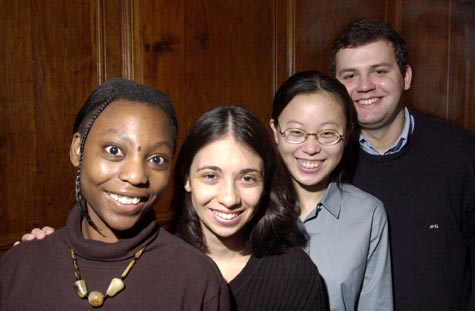University has a cosmopolitan flair

Every corner you turn you see different faces speaking different languages and expressing different viewpoints. It’s akin to taking a trip overseas without the pangs of having to cross over eight time zones to get there.
Some 3,000 foreign students (approximately 18 percent of the total student population) come to Harvard each year. An additional 2,000 foreign scholars also share the Harvard campus with their American peers. Most come from Asia, while others come from Europe, Central and South America, Africa, and Australia. Many stay for years, many just a single semester.
“Harvard is a world-class research institution and it most definitely attracts people from all over the world,” says Sharon Ladd, director of the Harvard International Office. “The University has a strong commitment to international education and to creating an environment in which international students and scholars are comfortable and thrive.”
Nationwide, there are some 500,000 foreign students studying at hundreds of colleges and universities while thousands of United States-based students are studying abroad. The U.S. Departments of Education and State are honoring all of them during International Education Week, Nov. 13-17.
According to the White House, the weeklong celebration is intended to increase support for international education programs and to recognize those efforts aimed at “preparing our citizens for a global environment while continuing to attract and educate future leaders from abroad.”
Mekhala Krishnamurthy ’02 came to Harvard from Bombay, India, to explore social studies. “I think American colleges in general offer a large number of options,” she explains. “That is one of the great advantages of a liberal arts education, and Harvard offers more than most places. … It has allowed me to do the extracurricular activities that I am very passionate about as well as [taking advantage of] the academic spread that it gives … and I think a lot of international students are attracted by that.”
Krishnamurthy is president of the Woodbridge Society, a support group and social organization formed by international students at Harvard six years ago. “I think we all come from different cultural contexts, but I also think we can celebrate that. When you come to Harvard you already have a sense of community and this [organization] is just building on that,” she states.
Not to be overlooked are those Harvard students who study abroad for a semester or longer. “There’s a lot of energy and enthusiasm on campus for going abroad,” says Jane Pavese, associate director of the Office of Career Services/Study Abroad, “and there are many opportunities for students to study subjects that we don’t teach here or to deepen their understanding of subjects that they begin studying here.”
About 170 Harvard undergraduates currently study or conduct research in foreign countries, including France, Italy, England, Argentina, Chile, Korea, Tanzania, Egypt, and Australia. “Students go all over the world. They study amazing things … and get credit for it, and all the while they stay on their academic track. It’s complementary to their progress toward a degree,” Pavese explains.
This international exchange of students and ideas helps shape and define Harvard’s rich and distinct cultural landscape. “I think there’s a feeling that the world is shrinking,” Ladd says, “and we want to be a part of educating world leaders and benefiting from their ideas and from the resources we are getting from other countries.”




